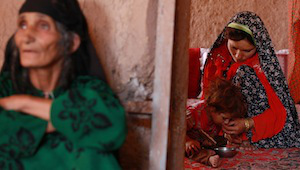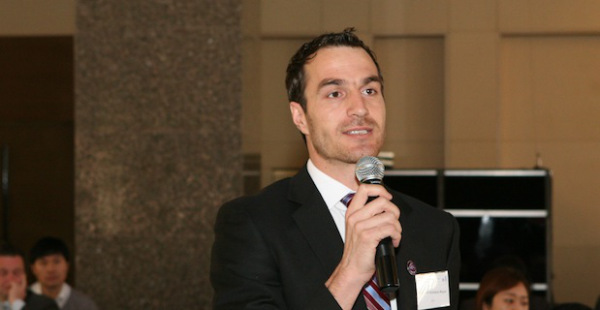
Villagers returning home as the sun sets in the Philippines. Credit: UN Photo
Any contemporary story on development in Asia-Pacific begins with reflection on massive gains achieved in the fight against poverty. The incidence of people living at less than 1.25 dollars a day fell from 54.5 percent in 1990 to 20.7 percent in 2010, with the number of extreme poor declining from 1.48 billion to 733 million. This precipitous decline in poverty has been accompanied by tremendous gains in access to health and education.
Without diminishing the progress made over the last 25 years, the region remains somewhat of a paradox: enviable growth and wealth on one hand and dire poverty and inequality on the other. Asia-Pacific remains home to more than 60 percent of the world’s extreme poor and two-thirds of the world’s hungry. While we’ve seen progress on the Millennium Development Goals (MDGs), it is uneven across and within countries. Despite eye-popping gross domestic product growth, increasing income inequality and vulnerability, infrastructure constraints, climate change and disaster risks threaten to undermine achievements.
As these threats increase, the region’s sources of finance and aid architecture are also rapidly changing. High rates of growth and challenging budget environments in many member-countries of the Organisation for Economic Co-operation and Development (OECD) have resulted in a decline of concessional development finance across Asia. This is against a backdrop of non-aid resources – such as remittances and foreign direct investment – increasing in importance and a growth in funding from “non-traditional” donors, including emerging economies and philanthropic organisations. On top of this, more countries have greater access to international capital markets to fund their development needs.
International efforts to make aid more effective — with conferences held from Rome (2003) to Paris (2005) and Accra (2008) — focused on good principles for aid providers and recipients, largely in the context of attaining the MDGs at the country level. It was less clear how these narrow principles would remain relevant in a rapidly changing global environment, particularly here in Asia-Pacific.
The Global Partnership for Effective Development Co-operation, launched at the fourth High Level Forum on Aid Effectiveness in Busan, recognised this and highlighted partnerships based on shared principles for better development results, nudging forward the agenda on MDG 8 (Develop a Global Partnership for Development). This was advanced further by the United Nations High Level Panel on the Post-2015 Development Agenda which called for a new global partnership framework – a transformative shift for co-operation and mutual accountability. In Bali, March 2013, the Panel agreed on the central importance of a global partnership for a “people-centred and planet-sensitive agenda”, based on “common humanity”.
These developments demonstrate an emerging view that any post-2015 framework needs to be supported by dynamic partnerships. If stakeholders ultimately agree, then the successor to Goal 8 will be central to all other post-2015 goals and applicable to all countries – unlike the MDG framework where goals 1-7 applied to developing countries and goal 8 primarily targeted developed countries.
Asia-Pacific has undertaken serious effort to examine emerging development challenges and goals from a regional perspective, even as the globally agreed post-2015 agenda is being finalised. The eighth Asia-Pacific Regional MDG Report 2012/2013 calls for integrating the three pillars of sustainable development – economic prosperity, social equity, and environmental responsibility into a post-2015 development framework.
By 2015, the ninth report will consolidate ideas from the region on development partnerships and offer insights to strengthen the successor to Goal 8. Three strategic areas for regional and global partnerships have been identified, which help articulate the region’s priorities for a successor to MDG 8. These include:
- regional public goods - e.g. promoting technology and knowledge transfer in the areas of food security, environment and health, which will not only help address development deficits in individual countries, but also have cross-border implications;
- data - strengthening the evidence base for planning and monitoring, including more disaggregation to measure and address inequalities and tracking energy-intensity of GDP rather than just (already low) per capita emissions; and
- finance ̶ expanding financing options for the Post-2015 agenda from both public and private sources.
Countries must each find ways to link the post-2015 and Global Partnership agendas – bringing together distinct goals to reflect nations’ different but complementary responsibilities for a shared global agenda. Collectively, we need to co-ordinate these interlinked agendas – including MDG 8 discussions and the Global Partnership – as well as identify ways to measure results from these partnerships and indicators attached to the successor to MDG 8.
Responding to the region’s aspirations, the Asian Development Bank stands ready to support this process any way we can.
Stephen P. Groff is the Asian Development Bank’s Vice-President for East Asia, Southeast Asia and the Pacific.
]]>On the eve of the Busan Partnership launch, the group, along with its development partners under the International Dialogue for Peacebuilding and Statebuilding, agreed on the New Deal for Engagement in Fragile States as a new paradigm for international co-operation with fragile and conflict affected states. Endorsed as an integral component of the Busan Partnership, there have been great achievements in implementing the principles agreed under the New Deal since 2011.
In line with the New Deal principles, several g7+ countries have conducted country-led and owned fragility assessments, the results of which, based on each unique context, are helping shape national development strategies. These strategies are meant to serve as one vision and one plan for development intervention. Compacts signed with development partners in Afghanistan, and Somalia, agree on national priorities in the given contexts and serve as tools for mutual accountability. Aid Management policies have also been designed and revised to reflect the principles of the New Deal.
However, we are still far behind on materialising most of our commitments. One major obstacle has been the lack of political buy-in needed to align policies with the new paradigm and context. Secondly, there has been demand for greater flexibility when it comes to development co-operation in fragile and conflict affected situations. Radical reforms to the way aid is managed in these countries are needed.
How can we maintain public services like health and education if the schools are burnt and the doctors are abducted?

A single mother feeds her child water and naan bread for breakfast in Farah province in Afghanistan’s west. Photo: UNAMA / Eric Kanalstein
The upcoming High-Level Meeting of the Global Partnership for Effective Development Co-operation will be a good opportunity to evaluate and assess the outcome of the New Deal. Moreover, the meeting will be a good forum to present some evidence on how peace and statebuilding elements can be founding factors for any development co-operation framework in conflict-affected situations, particularly in a global development framework to follow the Millennium Development Goals when they expire in 2015. Despite the fact that unfortunately the literature on the success stories of the peace and statebuilding in some of the countries is silent, there are good examples which can be discussed. We have some countries in East Asia/ Asia Pacific, Africa and South America, such as Timor-Leste, Cambodia, Vietnam, South Africa, where peace and statebuilding have led to resilience and development.
A good amount of experiences can be gathered and shared from g7+ countries on challenges for development co-operation in fragile situations, including on the Partnership’s agreed themes of private sector involvement and domestic revenue mobilisation. These are recognised as cornerstones for the New Deal’s peacebuilding and statebuilding goals, which include “Economic Foundation” and “Revenue and Services.” It is thus expected that the forum will bring together relevant stakeholders such as ministers, parliamentarians and civil society from g7+ countries to discuss how to address these issues.
At the meeting, we do expect that ministers will not only reiterate their commitments made in Busan but further help in seeking the political buy-in to realise them. We also hope that that discussion on fragility and conflict (as a theme) will also highlight the importance to fragile and conflict-affected states of recognising peace and effective institutions in the post-2015 development framework. In addition, the “Global partnership” – as a goal to complement and achieve the rest of the objectives of the said post-2015 global development framework — will require concrete political commitments at this forum.
Habib Ur Rehman Mayar is a Senior Policy Specialist at the g7+ Secretariat. You can reach him at habiburrehman.mayar@gmail.com
This article was first published on the Global Partnership’s Effective Development Co-operation Blog www.devcooperation.org.
]]>